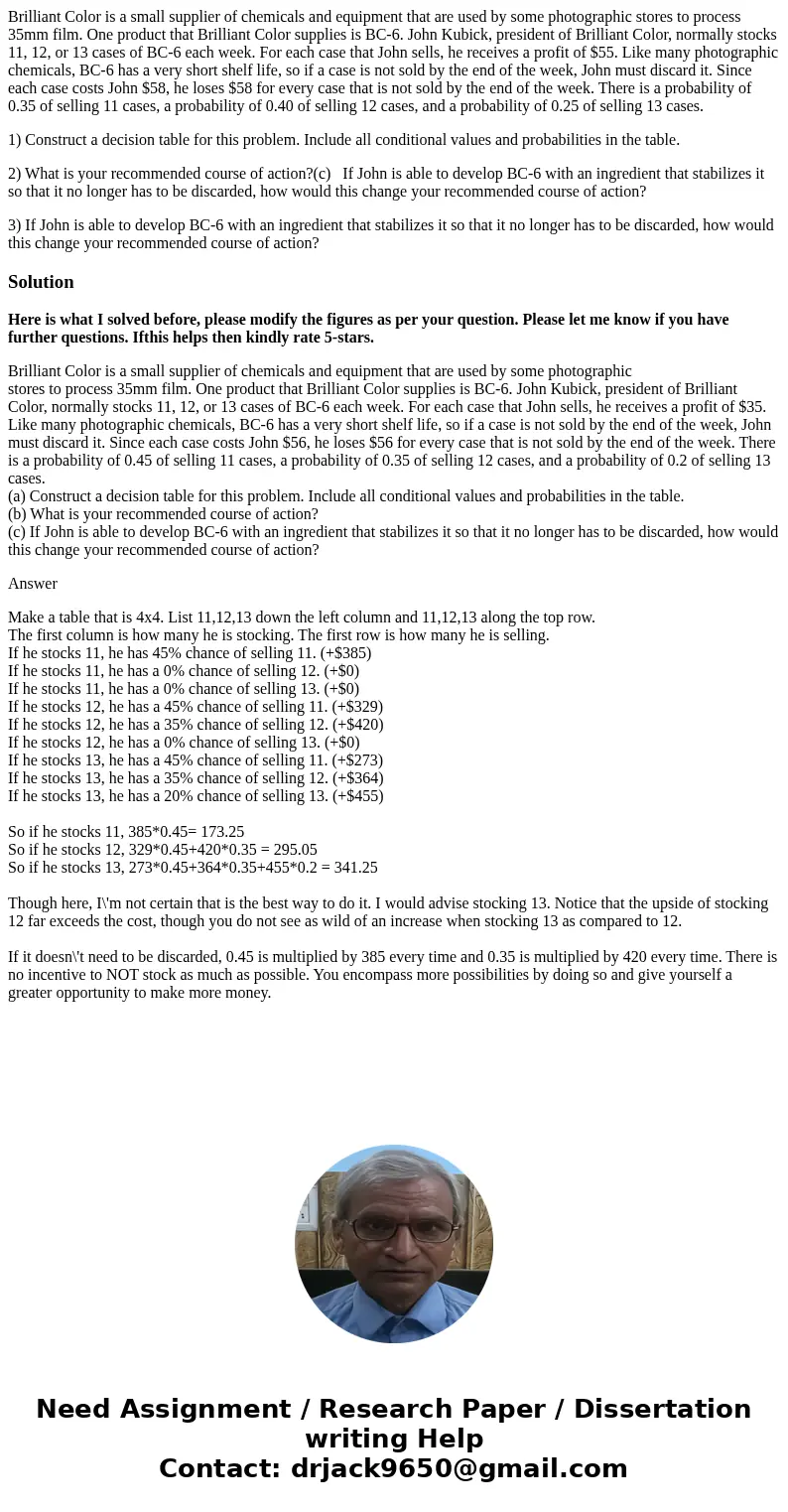Brilliant Color is a small supplier of chemicals and equipme
Brilliant Color is a small supplier of chemicals and equipment that are used by some photographic stores to process 35mm film. One product that Brilliant Color supplies is BC-6. John Kubick, president of Brilliant Color, normally stocks 11, 12, or 13 cases of BC-6 each week. For each case that John sells, he receives a profit of $55. Like many photographic chemicals, BC-6 has a very short shelf life, so if a case is not sold by the end of the week, John must discard it. Since each case costs John $58, he loses $58 for every case that is not sold by the end of the week. There is a probability of 0.35 of selling 11 cases, a probability of 0.40 of selling 12 cases, and a probability of 0.25 of selling 13 cases.
1) Construct a decision table for this problem. Include all conditional values and probabilities in the table.
2) What is your recommended course of action?(c) If John is able to develop BC-6 with an ingredient that stabilizes it so that it no longer has to be discarded, how would this change your recommended course of action?
3) If John is able to develop BC-6 with an ingredient that stabilizes it so that it no longer has to be discarded, how would this change your recommended course of action?
Solution
Here is what I solved before, please modify the figures as per your question. Please let me know if you have further questions. Ifthis helps then kindly rate 5-stars.
Brilliant Color is a small supplier of chemicals and equipment that are used by some photographic
stores to process 35mm film. One product that Brilliant Color supplies is BC-6. John Kubick, president of Brilliant Color, normally stocks 11, 12, or 13 cases of BC-6 each week. For each case that John sells, he receives a profit of $35. Like many photographic chemicals, BC-6 has a very short shelf life, so if a case is not sold by the end of the week, John must discard it. Since each case costs John $56, he loses $56 for every case that is not sold by the end of the week. There is a probability of 0.45 of selling 11 cases, a probability of 0.35 of selling 12 cases, and a probability of 0.2 of selling 13 cases.
(a) Construct a decision table for this problem. Include all conditional values and probabilities in the table.
(b) What is your recommended course of action?
(c) If John is able to develop BC-6 with an ingredient that stabilizes it so that it no longer has to be discarded, how would this change your recommended course of action?
Answer
Make a table that is 4x4. List 11,12,13 down the left column and 11,12,13 along the top row.
The first column is how many he is stocking. The first row is how many he is selling.
If he stocks 11, he has 45% chance of selling 11. (+$385)
If he stocks 11, he has a 0% chance of selling 12. (+$0)
If he stocks 11, he has a 0% chance of selling 13. (+$0)
If he stocks 12, he has a 45% chance of selling 11. (+$329)
If he stocks 12, he has a 35% chance of selling 12. (+$420)
If he stocks 12, he has a 0% chance of selling 13. (+$0)
If he stocks 13, he has a 45% chance of selling 11. (+$273)
If he stocks 13, he has a 35% chance of selling 12. (+$364)
If he stocks 13, he has a 20% chance of selling 13. (+$455)
So if he stocks 11, 385*0.45= 173.25
So if he stocks 12, 329*0.45+420*0.35 = 295.05
So if he stocks 13, 273*0.45+364*0.35+455*0.2 = 341.25
Though here, I\'m not certain that is the best way to do it. I would advise stocking 13. Notice that the upside of stocking 12 far exceeds the cost, though you do not see as wild of an increase when stocking 13 as compared to 12.
If it doesn\'t need to be discarded, 0.45 is multiplied by 385 every time and 0.35 is multiplied by 420 every time. There is no incentive to NOT stock as much as possible. You encompass more possibilities by doing so and give yourself a greater opportunity to make more money.

 Homework Sourse
Homework Sourse